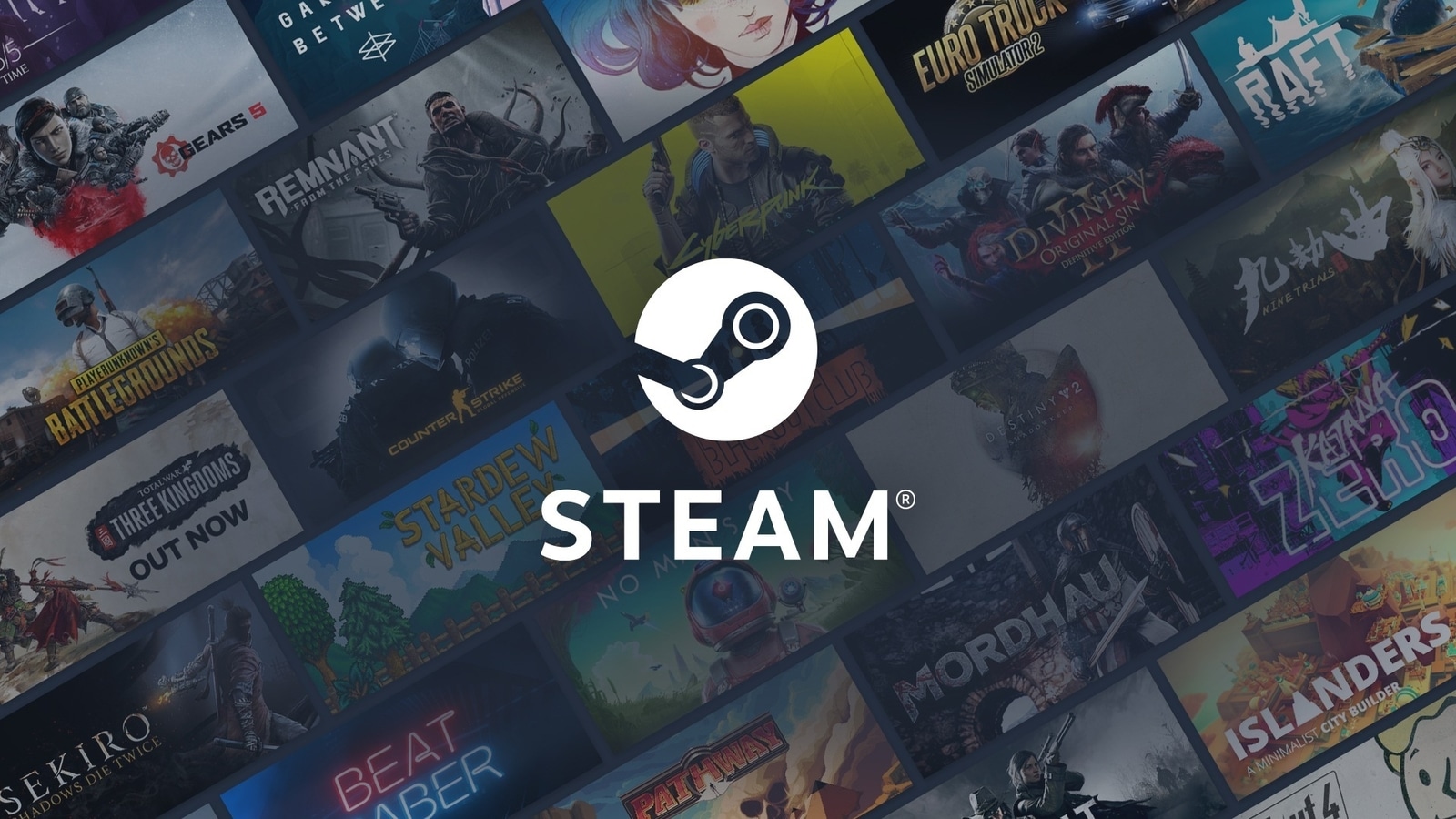The Razer Edge 5G is a good stab at creating an all-in-one cloud and mobile gaming device, with a good controller and access to 5G data. But it’s just not unique enough from your phone to justify the purchase for most people.
Pros
- Access to the best cloud services (and much more)
- Excellent AMOLED display with 144Hz refresh rate
- SD storage for emulation
- Good physical controller
Cons
- You already own a phone that does all of this
- 5G data plan is expensive
- Large bezels
- Poor speakers
Availability
- UKunavailable
- USARRP: $599
- Europeunavailable
- Canadaunavailable
- Australiaunavailable
-
Excellent gaming-centric screen6.8-inch AMOLED panel offers a FHD+ resolution and an ultra mode with a 144Hz refresh rate. -
Fast processorCloud gaming doesn’t need it, but it’s nice to have the flagship-level Snapdragon G3x Gen 1, which Razer collaborated with Qualcomm on. -
Attachable Kishi V2 Pro controllerThe device is touchscreen, but ships with the attachable Razer Kishi V2 controller with a comfortable grip, haptics and button remapping.
Introduction
Razer is the latest manufacturer to try its hand at uniting the various cloud gaming services in a handheld form factor.
This version of the Razer Edge wants to remove the most obvious barrier to cloud gaming; constant access to the cloud. Here there’s support for Verizon’s wideband 5G network for access to Xbox Cloud Gaming, Nvidia GeForce Now, Steam Link, and everything the Google Play Store has to offer. You can load your (totally legally acquired) retro ROMs on here too and use the Play Store’s emulators.
The Razer Edge 5G is a slim, rectangular 6.8-inch touchscreen device that runs on Android and has 5G and Wi-Fi. It has a powerful Snapdragon processor and 8GB of RAM. Sound familiar? Well, it is. Practically speaking, most of the people reading this already own a device that has all of this and quite a lot more – a smartphone.
Sure, it comes with the easily attachable Razer Kishi V2 Pro controller, but you can get a similar product for your phone too. Like the popular Backbone models, or more traditional Bluetooth controllers from 8bitdo and company.
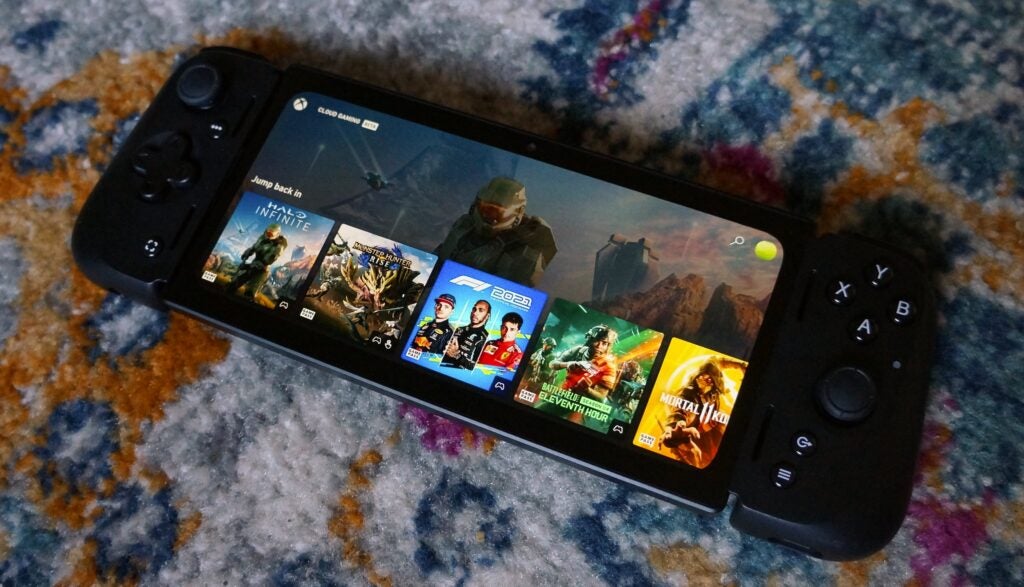
So, what is the point of it? Well, the Razer Edge 5G is designed for one purpose – as a dedicated gaming device, minus the distractions of your daily digital life and the worries about crippling your phone battery with high frame rate gaming. Hell, this thing can’t even make a phone call if you want it to. Is that worth $600 to you, plus an additional data plan ranging from $15-$30 a month ($180-$360 a year)?
Fellow handheld gaming devices, like the Nintendo Switch and Valve Steam Deck, have crystal clear use cases. You buy them because of x, y, and z. The Razer Edge 5G, on the surface, does not. So Let’s delve deeper…
Design and build
- Has a larger screen bezel than most phones
- Features a 6.8-inch screen
- Weighs in at 264g
The Razer Edge 5G build is smartphone adjacent, but with much larger bezels than you’d expect from a 2020s handset with a high screen to body ratio. I’m not sure why Razer made the decision to round the bezels at the corners rather than go with a fully rectangular display. It’s an odd decision that makes the bezels look even bigger.
The bezels make the Edge 5G larger overall (171.3 x 78.6 x 7.9 mm) than the Samsung Galaxy S23 Ultra (163.4 x 78.1 x 8.9 mm) which has the same 6.8-inch display size. The bezels are still much slimmer than the Nintendo Switch though.
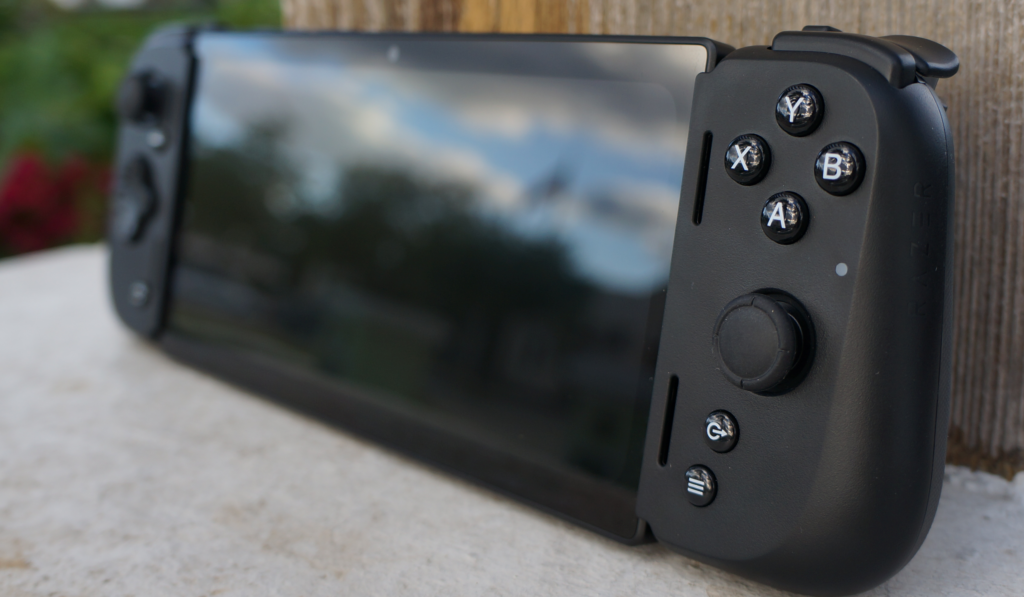
So, it’s a girthy beast, but in almost all cases you won’t be holding it with one hand like a smartphone. It’s 264g (401g with the controller attached) compared to the Galaxy S23 Ultra’s 234g, so not all that heavier than a flagship phone.
Part of the additional size is due to the fans on the rear of the handheld, which aim to keep it cool while playing demanding games. They get pretty loud during gaming experiences. There are tiny speakers at the bottom of the device that, as you’d expect when you see them, pump out awful sound.
Tearing up the Mexican landscape playing Forza Horizon 5 on Xbox Cloud Gaming sounded more like a wasp farting. Fortunately, there’s a 3.5mm headphone jack built into the controller and there’s Bluetooth compatibility too.
Controller
- Detachable controllers connect via USB-C
- Comfortable to grip
- Supports rumble
The bundled Razer Kishi V2 Pro is a spring-loaded, expandable pad that fits neatly into the USB-C port on the handset itself. The left side of the handset is slightly manoeuvrable when attached, so you can slide to keep it level.
If you’re used to your Xbox controller, for example, you might find the Kishi controls a little squished, as some people have complained. When trying (and largely failing) to execute devastating combos in Mortal Kombat 11 there were a few miscues on the shoulder buttons, especially with the M1 and M2 shoved in there. I prefer the way the Nintendo Switch aligns the button and the trigger for fewer false presses.
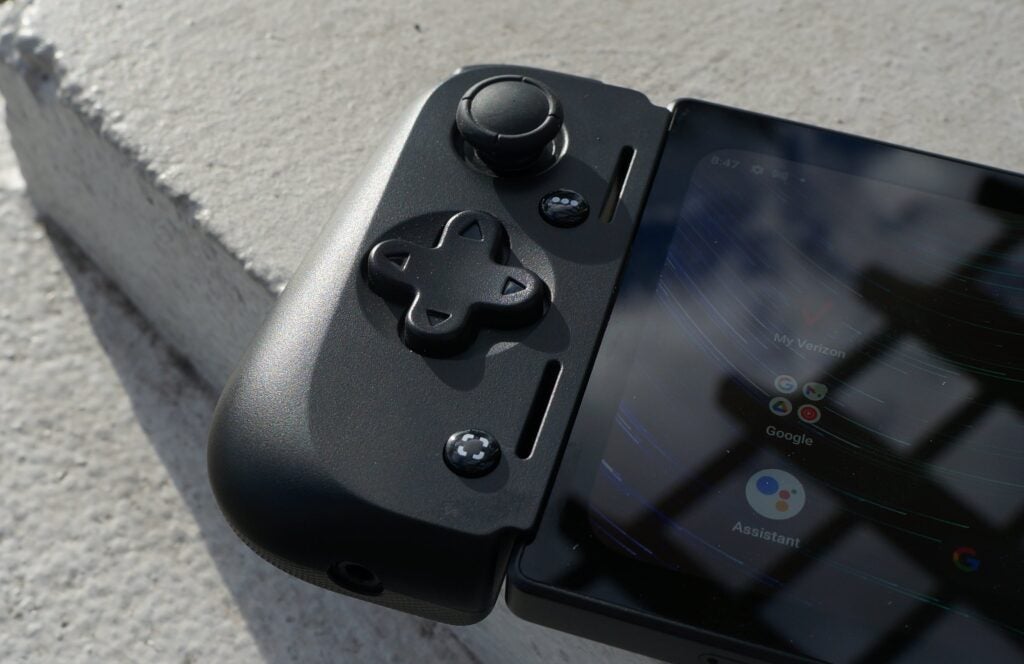
I am a fan of the analogue D-Pad here though, and the buttons are very tactile and responsive. There’s also controller remapping for the M1 and M2 buttons, which can become L3 and R3 buttons for use on PlayStation Remote Play.
The Kishi V2 Pro is really comfortable to grip and ergonomically sound. There’s also rumble support (where offered natively within games), which not all of these clip-on controllers do.
Specifications
- AMOLED display with 144Hz refresh rate
- Snapdragon G3x Gen 1 chip handles Android games well
- 20:9 aspect ratio can be awkward
The beauty of cloud gaming is that a lot of the heavy lifting is done by the cloud infrastructure – whether that’s the RTX 4080-powered GeForce Now tier or the Xbox Series X-powered Game Xbox Cloud Gaming platform. That means, in theory, you can play a AAA game like Cyberpunk 2077 in all its ray traced, high-frame rate glory without having to carry around a full rig with you.
However, to do those experiences justice, you still need some capable on-board specs. Namely, when it comes to the display. The 6.8-inch AMOLED display offers a FHD+ (2400×1080) resolution and a 144Hz refresh rate (an Ultra performance mode accessible through settings, default is 120Hz), which is the same refresh rate as many of the top PC monitors. While the 5G connectivity will enable you to play anywhere, the display doesn’t stand up too well against the bright Florida sun.
The 16:9 locked aspect ratio for Xbox Cloud Gaming also means gamers will deal with some black bars either side of the action of this 20:9 device.
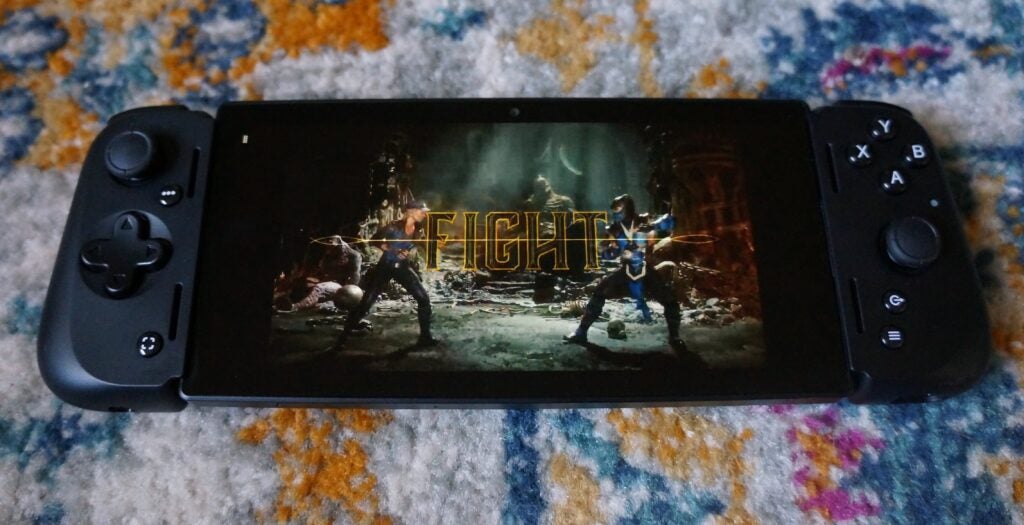
The SoC, the 2021 Snapdragon G3x Gen 1, is tuned for gaming. Essentially, it’s an overclocked version of the Snapdragon 888+ smartphone chip. It’s made up of eight-cores – 4x ARM Cortex A55, 3x A78 and a single X1. The inbuilt GPU is the Adreno 660. Together, they are capable of 120fps mobile gaming at Full HD and 4K at 60fsp (bear in mind the display isn’t capable of 4K), even without the cloud infrastructure bearing the weight.
This Snapdragon configuration of chips was built for mobile gaming on Android, and Razer collaborated in the development, so it handles everything the Google Play Store titles can throw at it with aplomb.
Battery life
- 5,000mAh battery capacity
- Lasts 5 hours of cloud gaming
- Battery recharges in just over 2 hours
A big selling point for the Razer Edge 5G is battery life – your smartphone’s battery life, that is. If you struggle to game on your smartphone because you know you won’t have enough juice to get you home in the evening, adding this device to the mix might be the solution. Or, you know, you could just buy an external battery pack for a fraction of the price of a Razer Edge 5G and play games on your smartphone until your heart’s content.
Anyway, the Razer Edge 5G’s 5,000mAh battery life is good for around five hours of cloud gaming. However, if you’re using 5G you might get a little less than that. That’s plenty for a long train ride, for example.
Over Wi-Fi at the 120Hz setting, 45 minutes of playing HiFi Rush from Xbox Cloud Gaming left me on 85% and a couple more hours with Forza Horizon 5 and Mortal Kombat 11 had me under 50%, so I’d say Razer’s estimates are pretty on point. On the highest performance mode (144Hz) using 5G, Halo Infinite knocked me down a solid 17% after 30 minutes.
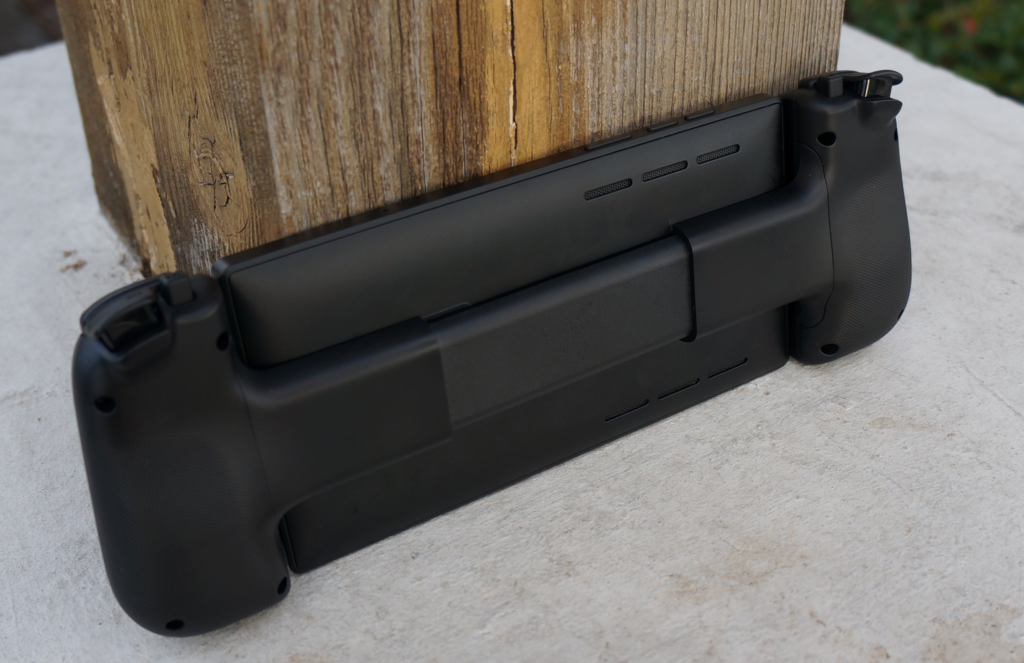
You are going to need to turn the handset off between sessions every time though, else you’ll simply come back to a flat console. There’s no sleep mode, for some reason. Razer tells me there’s a firmware update on the way to prevent the device from waking every time the controller is touched (accidentally or otherwise), which should help but not fix the problem.
The battery fully recharges in 2 hours and 8 minutes, while it was back at 50% after 50 minutes of charging via the Adaptive Fast Charging tech. I’ve seen reports that the device can get quite hot while charging, but that just wasn’t the case in my experience. You can also leave the controller attached while charging thanks to the USB-C port, but this is awkward as the cable gets in the way of the grip.
Performance
- Not as powerful as flagship smartphones
- Cloud performance is reliant on internet speeds
- SD cards lets you loads ROMs
This Razer Edge 5G offers good CPU performance despite not necessarily needing to. In Geekbench 5 benchmark testing, the Razer Edge 5G hit a multi-core score of 3419 and a single core score of 1172 . That’s about on par with last year’s Samsung Galaxy S22 base model (3574, 1163), but you’ll get more oomph from the 2023 models running the Snapdragon 8 Gen 2, or a dedicated gaming handset like the ASUS ROG Phone 6 (1304, 4302).
In terms of GPU, 3D Mark tests high performance scenarios (like how the console handles heat) over a period of time. The Razer Edge 5G scored 1527 in the Wild Life Extreme test, compared to the ASUS ROG Phone 6 which scored 2816. In the standard Wild Life test, the Razer Edge 5G scored 5570, compared with the Galaxy S22’s 7272.
When combined with the active cooling elements ingrained within the Razer Edge 5G, there isn’t much drop off in frame rate over a sustained period of time.
However, hitting the high benchmarks kind of defies the point of a device designed for cloud gaming. The ethos is that you don’t need the highest spec machine in order to get a great experience and, in turn, that keeps the price down. In fact, if you have a low-end smartphone, there’s a good reason to buy this as your gaming device.
With cloud gaming the top specs live in the cloud so you don’t have to buy them. Xbox Cloud Gaming, for example runs off an actual Xbox Series X, GeForce Now off a remote RTX 4080.
So, how does the experience stand up? Well, being a console gamer without a PC library to speak of, I spent much of the time playing Xbox Cloud Gaming titles.
You will lose a lot of the video pizzazz and sparkle due to the compression used by Microsoft to deliver these games, but anecdotally, frame rates are consistent. Infrequently when playing HiFi Rush (hardly the most visually demanding title out there) there’d be a slight breakdown in the image for a frame or too, but no buffering or screen tear issues over Wi-Fi or 5G. Naturally, this is connectivity dependent.
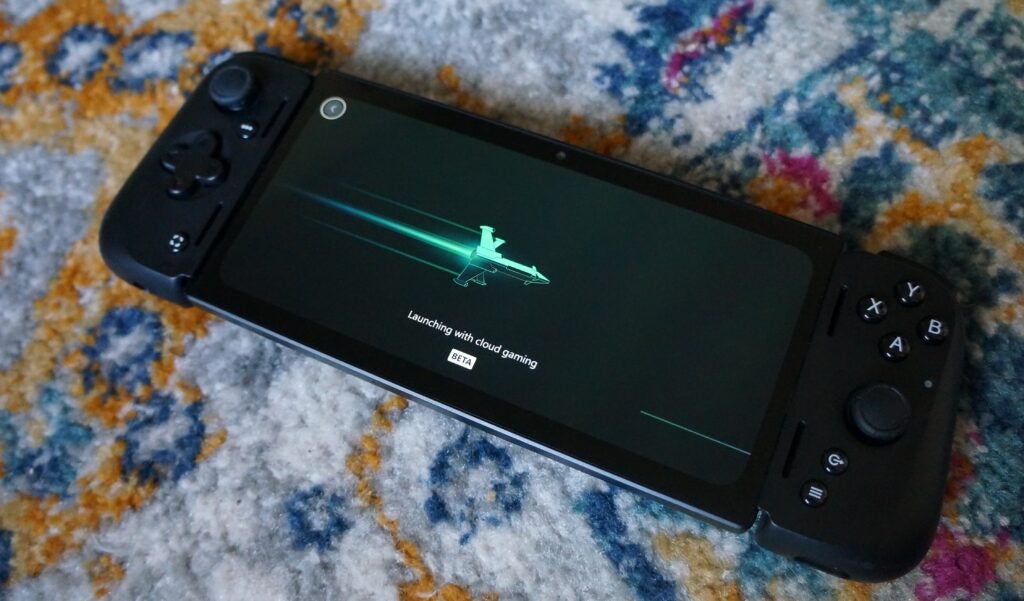
Of course, when you’re playing games designed for the largest screen in the house, you’re going to have issues. The tutorials for Mortal Kombat 11 were practically unreadable, but it’s the nature of the beast. If you’re buying this to play your console games on the go, it’s something to consider. Check which games have accessibility settings that enable you to increase the size of menu text.
As well as the cloud-powered services, there’s also the relay options like Remote Play for PlayStation consoles, Steam Link to connect to your main rig and play the game that way. You can also hook up to your Xbox console and access your games if you don’t have Game Pass and access to Xbox Cloud Gaming.
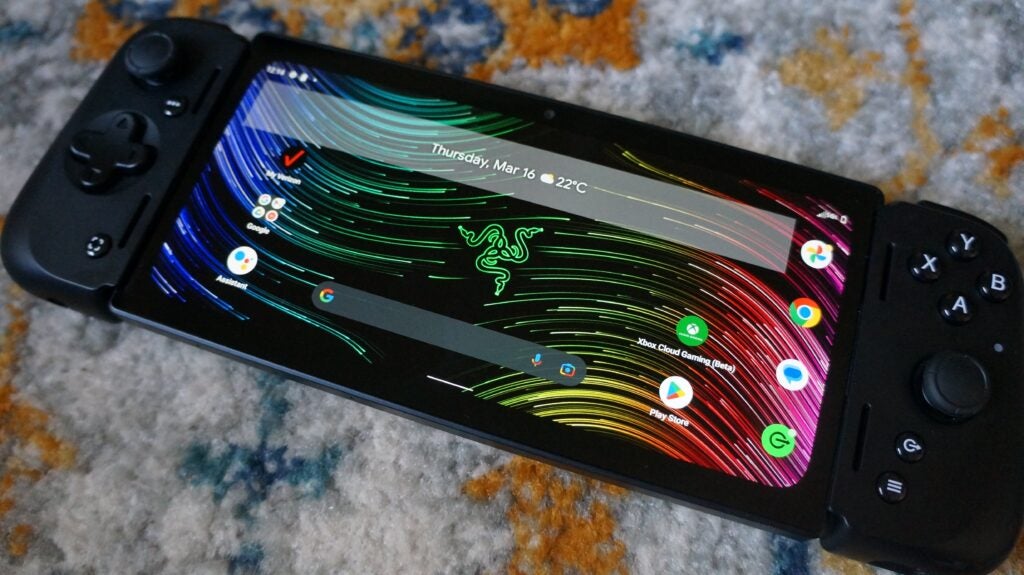
The Google Play options are practically limitless, and you can play with the touchscreen until your heart’s content. The SD card slot lets you load any ROMs you have and play them via emulators like Dolphin or RetroArch.
So, from the highest-end AAA PC games over the cloud, to the 8-bit NES classics. That’s quite the breadth of gaming. But again, this is nothing you can’t do on your existing smartphone. Do you need another device?
Latest deals
Should you buy it?
If you want to game on the go, but don’t want to use your phone:
The Razer Edge 5G can access the same services and play the same games as your phone, but you won’t be distracted and you won’t have to worry about battery life.
You’re happy to use your phone for cloud gaming:
Look, you probably own this device already – a 5G, touchscreen device with access to cloud services, remote play and a mobile app store. There are lots of gaming controllers around and battery packs to extend the life of your phone.
Final Thoughts
I like the Razer Edge 5G, I really do. It’s well thought out and absolutely dialled-in on its core focus – to completely remove boundaries to playing your favourite games anywhere, leaving no stone unturned.
However, the Razer Edge 5G is hard to recommend unless you’re determined to completely segregate your gaming life from your smartphone life. What more could Razer do to make this device more essential? Nothing really. The vision has been executed well, but it just feels very unessential.
How we test
We tested the Razer Edge 5G by playing a variety of different games, while also using benchmark tests to determine performance. We also measured the battery life by playing games.
Spent 3 weeks with the Razer Edge 5G, mostly playing Xbox Cloud Gaming titles
Played a range of title like Mortal Kombat 11, HiFi Rush, Forza Horizon 5 and Halo Infinite
FAQs
No, it’s available in the USA, exclusive to the Verizon Network. There’s a Wi-Fi only edition too that costs $399.
Yes, through the Steam Link feature which hooks up to your gaming rig and relays the action from there. You can also access the Nvidia GeForce Now cloud platform for all your PC games. It’s not powerful enough to handle the big AAA PC games via the built-in specs
Absolutely. There are emulation apps like Dolphin and RetroArch and you can insert a microSD card to play your (legally acquired) retro game libraries.
Trusted Reviews test data
UK RRP
USA RRP
EU RRP
CA RRP
AUD RRP
Manufacturer
Screen Size
Storage Capacity
Front Camera
IP rating
Battery
Size (Dimensions)
Weight
Operating System
Release Date
First Reviewed Date
Model Variants
Resolution
HDR
Refresh Rate
Ports
GPU
RAM
Connectivity
Colours
Display Technology
Touch Screen
Convertible?
The Razer Edge 5G is a good stab at creating an all-in-one cloud and mobile gaming device, with a good controller and access to 5G data. But it’s just not unique enough from your phone to justify the purchase for most people.
Pros
- Access to the best cloud services (and much more)
- Excellent AMOLED display with 144Hz refresh rate
- SD storage for emulation
- Good physical controller
Cons
- You already own a phone that does all of this
- 5G data plan is expensive
- Large bezels
- Poor speakers
Availability
- UKunavailable
- USARRP: $599
- Europeunavailable
- Canadaunavailable
- Australiaunavailable
-
Excellent gaming-centric screen6.8-inch AMOLED panel offers a FHD+ resolution and an ultra mode with a 144Hz refresh rate. -
Fast processorCloud gaming doesn’t need it, but it’s nice to have the flagship-level Snapdragon G3x Gen 1, which Razer collaborated with Qualcomm on. -
Attachable Kishi V2 Pro controllerThe device is touchscreen, but ships with the attachable Razer Kishi V2 controller with a comfortable grip, haptics and button remapping.
Introduction
Razer is the latest manufacturer to try its hand at uniting the various cloud gaming services in a handheld form factor.
This version of the Razer Edge wants to remove the most obvious barrier to cloud gaming; constant access to the cloud. Here there’s support for Verizon’s wideband 5G network for access to Xbox Cloud Gaming, Nvidia GeForce Now, Steam Link, and everything the Google Play Store has to offer. You can load your (totally legally acquired) retro ROMs on here too and use the Play Store’s emulators.
The Razer Edge 5G is a slim, rectangular 6.8-inch touchscreen device that runs on Android and has 5G and Wi-Fi. It has a powerful Snapdragon processor and 8GB of RAM. Sound familiar? Well, it is. Practically speaking, most of the people reading this already own a device that has all of this and quite a lot more – a smartphone.
Sure, it comes with the easily attachable Razer Kishi V2 Pro controller, but you can get a similar product for your phone too. Like the popular Backbone models, or more traditional Bluetooth controllers from 8bitdo and company.

So, what is the point of it? Well, the Razer Edge 5G is designed for one purpose – as a dedicated gaming device, minus the distractions of your daily digital life and the worries about crippling your phone battery with high frame rate gaming. Hell, this thing can’t even make a phone call if you want it to. Is that worth $600 to you, plus an additional data plan ranging from $15-$30 a month ($180-$360 a year)?
Fellow handheld gaming devices, like the Nintendo Switch and Valve Steam Deck, have crystal clear use cases. You buy them because of x, y, and z. The Razer Edge 5G, on the surface, does not. So Let’s delve deeper…
Design and build
- Has a larger screen bezel than most phones
- Features a 6.8-inch screen
- Weighs in at 264g
The Razer Edge 5G build is smartphone adjacent, but with much larger bezels than you’d expect from a 2020s handset with a high screen to body ratio. I’m not sure why Razer made the decision to round the bezels at the corners rather than go with a fully rectangular display. It’s an odd decision that makes the bezels look even bigger.
The bezels make the Edge 5G larger overall (171.3 x 78.6 x 7.9 mm) than the Samsung Galaxy S23 Ultra (163.4 x 78.1 x 8.9 mm) which has the same 6.8-inch display size. The bezels are still much slimmer than the Nintendo Switch though.

So, it’s a girthy beast, but in almost all cases you won’t be holding it with one hand like a smartphone. It’s 264g (401g with the controller attached) compared to the Galaxy S23 Ultra’s 234g, so not all that heavier than a flagship phone.
Part of the additional size is due to the fans on the rear of the handheld, which aim to keep it cool while playing demanding games. They get pretty loud during gaming experiences. There are tiny speakers at the bottom of the device that, as you’d expect when you see them, pump out awful sound.
Tearing up the Mexican landscape playing Forza Horizon 5 on Xbox Cloud Gaming sounded more like a wasp farting. Fortunately, there’s a 3.5mm headphone jack built into the controller and there’s Bluetooth compatibility too.
Controller
- Detachable controllers connect via USB-C
- Comfortable to grip
- Supports rumble
The bundled Razer Kishi V2 Pro is a spring-loaded, expandable pad that fits neatly into the USB-C port on the handset itself. The left side of the handset is slightly manoeuvrable when attached, so you can slide to keep it level.
If you’re used to your Xbox controller, for example, you might find the Kishi controls a little squished, as some people have complained. When trying (and largely failing) to execute devastating combos in Mortal Kombat 11 there were a few miscues on the shoulder buttons, especially with the M1 and M2 shoved in there. I prefer the way the Nintendo Switch aligns the button and the trigger for fewer false presses.

I am a fan of the analogue D-Pad here though, and the buttons are very tactile and responsive. There’s also controller remapping for the M1 and M2 buttons, which can become L3 and R3 buttons for use on PlayStation Remote Play.
The Kishi V2 Pro is really comfortable to grip and ergonomically sound. There’s also rumble support (where offered natively within games), which not all of these clip-on controllers do.
Specifications
- AMOLED display with 144Hz refresh rate
- Snapdragon G3x Gen 1 chip handles Android games well
- 20:9 aspect ratio can be awkward
The beauty of cloud gaming is that a lot of the heavy lifting is done by the cloud infrastructure – whether that’s the RTX 4080-powered GeForce Now tier or the Xbox Series X-powered Game Xbox Cloud Gaming platform. That means, in theory, you can play a AAA game like Cyberpunk 2077 in all its ray traced, high-frame rate glory without having to carry around a full rig with you.
However, to do those experiences justice, you still need some capable on-board specs. Namely, when it comes to the display. The 6.8-inch AMOLED display offers a FHD+ (2400×1080) resolution and a 144Hz refresh rate (an Ultra performance mode accessible through settings, default is 120Hz), which is the same refresh rate as many of the top PC monitors. While the 5G connectivity will enable you to play anywhere, the display doesn’t stand up too well against the bright Florida sun.
The 16:9 locked aspect ratio for Xbox Cloud Gaming also means gamers will deal with some black bars either side of the action of this 20:9 device.

The SoC, the 2021 Snapdragon G3x Gen 1, is tuned for gaming. Essentially, it’s an overclocked version of the Snapdragon 888+ smartphone chip. It’s made up of eight-cores – 4x ARM Cortex A55, 3x A78 and a single X1. The inbuilt GPU is the Adreno 660. Together, they are capable of 120fps mobile gaming at Full HD and 4K at 60fsp (bear in mind the display isn’t capable of 4K), even without the cloud infrastructure bearing the weight.
This Snapdragon configuration of chips was built for mobile gaming on Android, and Razer collaborated in the development, so it handles everything the Google Play Store titles can throw at it with aplomb.
Battery life
- 5,000mAh battery capacity
- Lasts 5 hours of cloud gaming
- Battery recharges in just over 2 hours
A big selling point for the Razer Edge 5G is battery life – your smartphone’s battery life, that is. If you struggle to game on your smartphone because you know you won’t have enough juice to get you home in the evening, adding this device to the mix might be the solution. Or, you know, you could just buy an external battery pack for a fraction of the price of a Razer Edge 5G and play games on your smartphone until your heart’s content.
Anyway, the Razer Edge 5G’s 5,000mAh battery life is good for around five hours of cloud gaming. However, if you’re using 5G you might get a little less than that. That’s plenty for a long train ride, for example.
Over Wi-Fi at the 120Hz setting, 45 minutes of playing HiFi Rush from Xbox Cloud Gaming left me on 85% and a couple more hours with Forza Horizon 5 and Mortal Kombat 11 had me under 50%, so I’d say Razer’s estimates are pretty on point. On the highest performance mode (144Hz) using 5G, Halo Infinite knocked me down a solid 17% after 30 minutes.

You are going to need to turn the handset off between sessions every time though, else you’ll simply come back to a flat console. There’s no sleep mode, for some reason. Razer tells me there’s a firmware update on the way to prevent the device from waking every time the controller is touched (accidentally or otherwise), which should help but not fix the problem.
The battery fully recharges in 2 hours and 8 minutes, while it was back at 50% after 50 minutes of charging via the Adaptive Fast Charging tech. I’ve seen reports that the device can get quite hot while charging, but that just wasn’t the case in my experience. You can also leave the controller attached while charging thanks to the USB-C port, but this is awkward as the cable gets in the way of the grip.
Performance
- Not as powerful as flagship smartphones
- Cloud performance is reliant on internet speeds
- SD cards lets you loads ROMs
This Razer Edge 5G offers good CPU performance despite not necessarily needing to. In Geekbench 5 benchmark testing, the Razer Edge 5G hit a multi-core score of 3419 and a single core score of 1172 . That’s about on par with last year’s Samsung Galaxy S22 base model (3574, 1163), but you’ll get more oomph from the 2023 models running the Snapdragon 8 Gen 2, or a dedicated gaming handset like the ASUS ROG Phone 6 (1304, 4302).
In terms of GPU, 3D Mark tests high performance scenarios (like how the console handles heat) over a period of time. The Razer Edge 5G scored 1527 in the Wild Life Extreme test, compared to the ASUS ROG Phone 6 which scored 2816. In the standard Wild Life test, the Razer Edge 5G scored 5570, compared with the Galaxy S22’s 7272.
When combined with the active cooling elements ingrained within the Razer Edge 5G, there isn’t much drop off in frame rate over a sustained period of time.
However, hitting the high benchmarks kind of defies the point of a device designed for cloud gaming. The ethos is that you don’t need the highest spec machine in order to get a great experience and, in turn, that keeps the price down. In fact, if you have a low-end smartphone, there’s a good reason to buy this as your gaming device.
With cloud gaming the top specs live in the cloud so you don’t have to buy them. Xbox Cloud Gaming, for example runs off an actual Xbox Series X, GeForce Now off a remote RTX 4080.
So, how does the experience stand up? Well, being a console gamer without a PC library to speak of, I spent much of the time playing Xbox Cloud Gaming titles.
You will lose a lot of the video pizzazz and sparkle due to the compression used by Microsoft to deliver these games, but anecdotally, frame rates are consistent. Infrequently when playing HiFi Rush (hardly the most visually demanding title out there) there’d be a slight breakdown in the image for a frame or too, but no buffering or screen tear issues over Wi-Fi or 5G. Naturally, this is connectivity dependent.

Of course, when you’re playing games designed for the largest screen in the house, you’re going to have issues. The tutorials for Mortal Kombat 11 were practically unreadable, but it’s the nature of the beast. If you’re buying this to play your console games on the go, it’s something to consider. Check which games have accessibility settings that enable you to increase the size of menu text.
As well as the cloud-powered services, there’s also the relay options like Remote Play for PlayStation consoles, Steam Link to connect to your main rig and play the game that way. You can also hook up to your Xbox console and access your games if you don’t have Game Pass and access to Xbox Cloud Gaming.

The Google Play options are practically limitless, and you can play with the touchscreen until your heart’s content. The SD card slot lets you load any ROMs you have and play them via emulators like Dolphin or RetroArch.
So, from the highest-end AAA PC games over the cloud, to the 8-bit NES classics. That’s quite the breadth of gaming. But again, this is nothing you can’t do on your existing smartphone. Do you need another device?
Latest deals
Should you buy it?
If you want to game on the go, but don’t want to use your phone:
The Razer Edge 5G can access the same services and play the same games as your phone, but you won’t be distracted and you won’t have to worry about battery life.
You’re happy to use your phone for cloud gaming:
Look, you probably own this device already – a 5G, touchscreen device with access to cloud services, remote play and a mobile app store. There are lots of gaming controllers around and battery packs to extend the life of your phone.
Final Thoughts
I like the Razer Edge 5G, I really do. It’s well thought out and absolutely dialled-in on its core focus – to completely remove boundaries to playing your favourite games anywhere, leaving no stone unturned.
However, the Razer Edge 5G is hard to recommend unless you’re determined to completely segregate your gaming life from your smartphone life. What more could Razer do to make this device more essential? Nothing really. The vision has been executed well, but it just feels very unessential.
How we test
We tested the Razer Edge 5G by playing a variety of different games, while also using benchmark tests to determine performance. We also measured the battery life by playing games.
Spent 3 weeks with the Razer Edge 5G, mostly playing Xbox Cloud Gaming titles
Played a range of title like Mortal Kombat 11, HiFi Rush, Forza Horizon 5 and Halo Infinite
FAQs
No, it’s available in the USA, exclusive to the Verizon Network. There’s a Wi-Fi only edition too that costs $399.
Yes, through the Steam Link feature which hooks up to your gaming rig and relays the action from there. You can also access the Nvidia GeForce Now cloud platform for all your PC games. It’s not powerful enough to handle the big AAA PC games via the built-in specs
Absolutely. There are emulation apps like Dolphin and RetroArch and you can insert a microSD card to play your (legally acquired) retro game libraries.
Trusted Reviews test data
UK RRP
USA RRP
EU RRP
CA RRP
AUD RRP
Manufacturer
Screen Size
Storage Capacity
Front Camera
IP rating
Battery
Size (Dimensions)
Weight
Operating System
Release Date
First Reviewed Date
Model Variants
Resolution
HDR
Refresh Rate
Ports
GPU
RAM
Connectivity
Colours
Display Technology
Touch Screen
Convertible?

